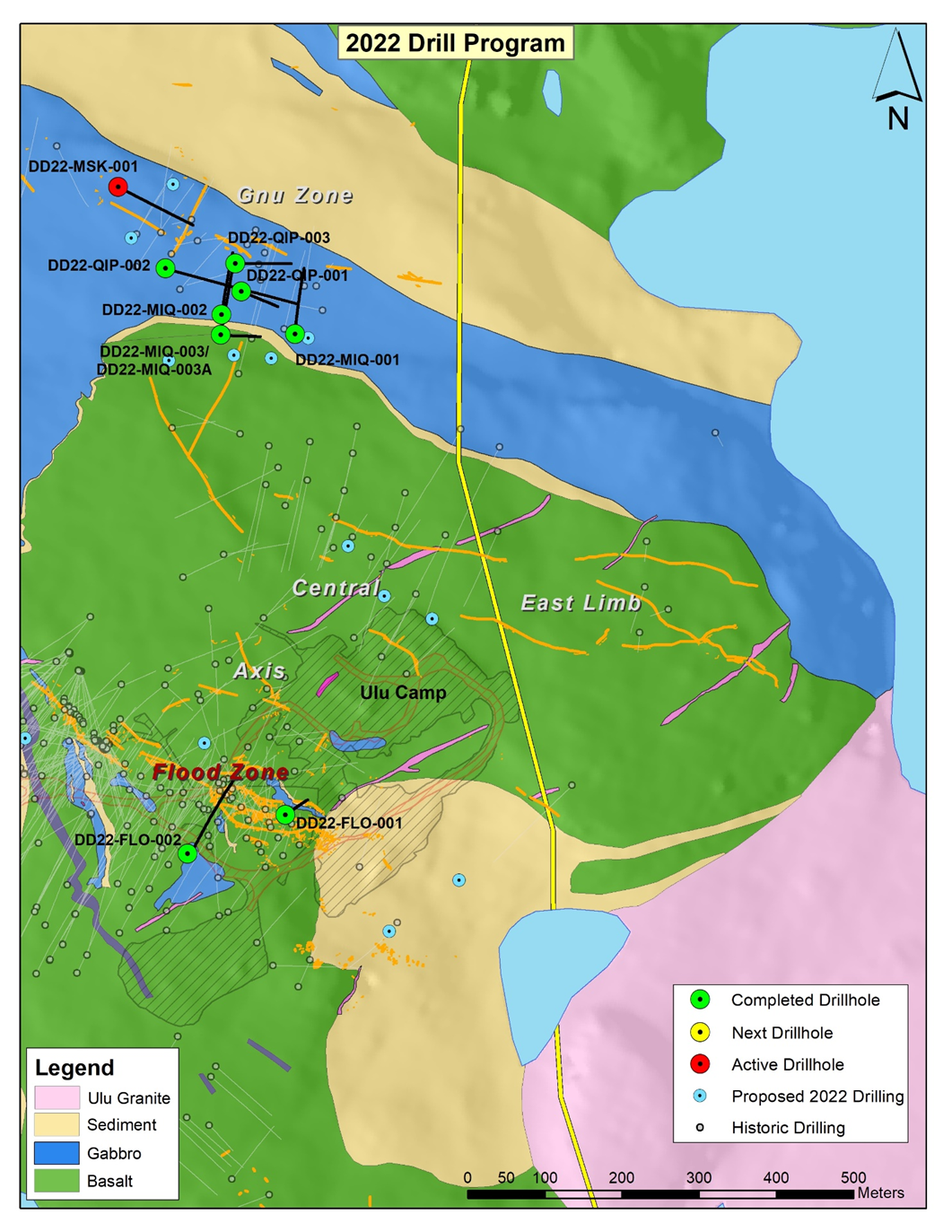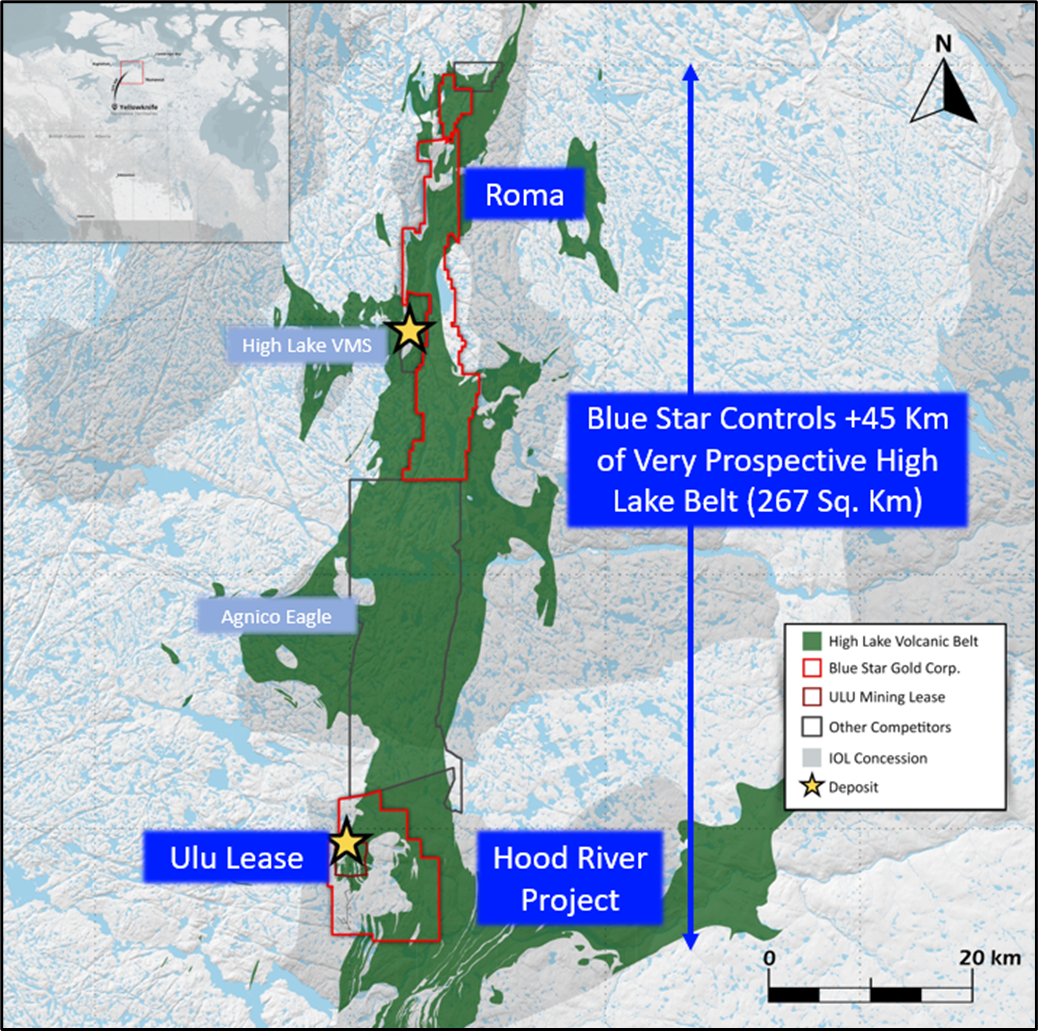Vancouver, British Columbia – July 20, 2022: Blue Star Gold Corp. (TSXV: BAU) (FSE: 5WP0) (OTCQB: BAUFF) (“Blue Star” or the “Company”) announces the first drill results from its 2022 exploration program on the Ulu, Hood River and Roma projects located in the Kitikmeot Region of Nunavut. Assays from the initial Flood Zone drill hole are reported herein. The Company is also providing an update on additional exploration activities on its multi-prong exploration effort across its highly prospective Ulu, Hood River, and Roma projects.
Highlights:
DD22-FLO-002 returned two significant intercepts: 15.00 grams/tonne (“g/t”) gold over 17.65 metres (m), including a 6.00 m interval of 25.74 g/t gold starting at 115.14 m downhole, and 5.31 g/t gold over 5.70 m.
DD22-FLO-001 has returned strong intervals of acicular arsenopyrite mineralisation from 5.36 m to 12.00 m (6.64 m core length) and from 14.70 m to 17.00 m (2.30 m core length); assays are pending.
DD22-MIQ-001 intersected a new blind polymetallic vein in the Gnu Zone, from 95.90 m to 100.25 m (4.35 m core length); assays are pending.
Four additional drill holes have been completed in the Gnu Zone target area with samples shipped and assays pending.
Heli-borne-geophysics data acquisition and processing has been completed.
Blue Star’s CEO, Grant Ewing, commented, “Our 2022 exploration campaign has begun with impressive results returned from DD22-FLO-002, which has the highest value (grams gold x width metres) of all intercepts drilled by Blue Star. The intercepts in FLO-002 are expected to allow the conversion of existing inferred ounces to an indicated category and expand the Flood Zone resource. Our understanding of controls on mineralization has improved significantly over the last several months and this has contributed to better targeting at both the deposit and property scale. Several promising target areas throughout our prospective landholdings will be assessed during the current program.”
Discussion of results
The drilling at the Flood Zone is designed to provide additional data in areas where geological and resource modeling have data gaps and drilling at the Gnu Zone area is designed to expand the known extents of mineralised structures.
DD22-FLO-002 intersected 15.00 g/t gold over 17.65 m, and 5.30 g/t gold over 5.70 m, in a sparsely drilled area of the Flood Zone at approximately 100 m vertical depth. Both intercepts are within a structurally disrupted zone between a high Fe-Ti basalt unit and lower Fe-Ti basalt unit immediately adjacent to the sediment fold hinge. Drill hole DD22-FLO-001 tested the width of the Flood Zone in a near surface area where previous drilling ended prematurely. Core lengths of 6.64 m and 2.30 m with acicular arsenopyrite mineralisation were encountered in DD22-FLO-001; assays are pending.
Assays are pending for all holes drilled in the Gnu Zone area including: DD22-MIQ-001, an eastward step-out along and down dip of the known acicular arsenopyrite zone (it intersected a blind polymetallic vein however it did not intersect the target zone); DD22-MIQ-002, a westward step-out along the known acicular arsenopyrite trend which intersected 2.25 m of 6% acicular arsenopyrite; and DD22-MIQ-003/003A.
Other Gnu Zone drill holes completed to date include DD22-QIP-001 and DD22-QIP-002 that are evaluating the new polymetallic vein discovery (20.8 g/t Au over 8.15 m) made by Blue Star in 2021. All of these holes are being sampled or have samples at the laboratory and these assays will be released once results are received.
Darren Lindsay, Blue Star’s VP Exploration stated: “The team has done an outstanding job from getting the camp running, to successfully completing the regional magnetics program over Roma and Hood River, to delivering these initial spectacular results (FLO-002) in areas of geological uncertainty within the existing Flood Zone deposit. In addition, another polymetallic vein has been discovered while determining the extent of the 2021 vein discovery at the Gnu Zone. On top of these successes the exploration team is also very excited about implementing the detectORE™ system of Portable PPB Pty Ltd in our regional exploration efforts.”

Figure 1: DD22-FLO-002 – visible gold in interval of 17.65 m grading 15.00 g/t gold.

Figure 2: Core photo of MIQ-001; new vein discovery from 95.90 m to 100.25 m, altered gabbro with strong quartz-pyrrhotite-pyrite-chalcopyrite-sphalerite veining. Assays are pending.

Figure 3: Table of results to date.

Figure 4: Table of drill collar locations for holes reported in this release.

Figure 5: Plan map of drill holes and progress.
Exploration Program Progress Summary
The geophysical component of the 2022 program is now complete with 1,690 line km at 50 – 100m line spacing flown over the entire Roma landholdings, and 1,365 line kms at 50m line spacing flown over the entire Ulu lease and Hood River concession that was not previously conducted in the 2021 survey. Final deliverables are pending which will further guide our mapping and prospecting programs over the landholdings.
An orientation survey over the known areas of mineralization in the Ulu lease including the Flood Zone and the Gnu Zone have been completed with samples processed by the detectORE™ system for rapid low level gold analysis by portable XRF. Anomalous zones were detected in the areas expected including down-ice of the Flood Zone deposit. Subsequently the regional sampling program on the Roma project has been initiated.
Blue Star Gold’s Projects
The Company’s properties are located approximately 525 km NNE of Yellowknife, NT in the Kitikmeot region of western Nunavut. The hamlet of Kugluktuk is approximately 210 km to the NW. The Roma property lies approximately 30 km north of the Ulu-Hood River property. The total area of Blue Star’s projects encompasses 267 km2 of the highly prospective and underexplored High Lake Greenstone Belt.
The Ulu mining lease hosts the advanced stage Flood Zone gold deposit, where a significant high-grade gold resource has been outlined. Several additional gold prospects (including, but not limited to, Zebra, Contact, Central, Axis, and Gnu) are spatially related to the axis of the 5 km long Ulu Fold, which extends from the Ulu lease onto the northern part of the Hood River property and culminates at the North Fold Nose Zone. The recent expansion of the Hood River concession added several new target zones south of the Flood Zone gold deposit. The eastern side of the Hood River property is contiguous to the Ulu lease, and hosts over twenty known gold showings. The Hood River prospects have the same deformation history (including tight folding) as well as similar mineralization styles (acicular arsenopyrite and polymetallic quartz veins) and stratigraphic sequences as the Flood Zone. One of the most prospective target areas on the eastern Hood River property is the 4 km long Crown-Pro trend which has seen only limited drilling.
The Roma project lies in the northern section of the High Lake Greenstone Belt. The project covers high grade gold showings discovered by previous explorers, notably BHP Minerals from 1988 to 1994. Multiple significant gold showings are present within a 6.5 km x 2.4 km area on the historic Roma claim block. The original showing is a 0.30 to 3.0 m wide quartz vein exposed in outcrop and boulders for 2.0 km. In 1991, BHP drilled 10 shallow holes totalling 465 metres to test 1.72 km of strike of the vein. All drill holes intersected quartz veins from 15 m to 37 m vertically below surface. Visible gold was noted in three of the drillholes and the best results were 12.38 g/t Au over 2.31 m (including 64.0 g/t Au over 0.37 m) from DDH MD-01, and 8.69 g/t Au over 1.87 m from MD-03. No drilling was conducted downdip of the high-grade intersection in DDH MD-01 and no step out drilling to the north from this intercept was conducted. No follow up drilling is known to have been completed on this property since BHP’s initial drill program in the 1990’s. The Company has not verified the historical results from the Roma property and has presented information obtained from two assessment reports submitted by BHP Minerals Canada Ltd.; McMaster, G., (1995). Roma 3,4,5 and 6 Claims 1995 Geological and Geochemical Report, and Anonby, L. and Jopson, W., (1992). Geological, Geochemical, Geophysical and Drilling Report on the Roma 1 and 2 Claims.
The site of the future deep-water port at Gray’s Bay is 40 – 100 km to the north of the properties, and the proposed route corridor for the all-weather Gray’s Bay road passes in close proximity to the Roma, Ulu, and Hood River projects.

Figure 6: Blue Star projects.
Technical Disclosure
Drill holes reported had core samples cut by core saw with one half of the core retained and the other half sent for analysis. Samples were prepared by ALS Yellowknife-Geochemistry and analyzed at ALS Global, North Vancouver. Gold analysis was by fire assay using ALS code Au-AA26 and multielement analysis by code ME-MS61. Control samples include a crush duplicate every twenty samples; certified reference material was inserted once every ten samples. Reported assay intervals are uncapped, use a minimum 1 g/t gold assay cut off with the inclusion of up to 2 m of material below cut-off. True widths for all but the Flood Zone are not known due to lack of drilling and may range from 50% to 95% of drilled lengths.
DetectORE™ is a new rapid geochemical analysis technique developed by Portable PPB Pty Ltd to be used at exploration sites. Regional geochemical samples (1000m x 50m grid) consisting of till samples collected from frost boils were sieved to <1 mm to capture approximately 2kg of material; samples were dried with a 500 gram split used in the analysis technique which includes final reading of the sample collector devices by pXRF, reject material was also analyzed by pXRF for multi-element review and retained. The QP has ensured the QAQC program of detectORE™ of two reference materials per processing batch (90 samples) and at least two certified collector devices are analyzed during the analysis stage was followed. Additionally, the Company inserted one blank, one duplicate, and one known anomalous sample into the initial processing batches.
Qualified Person
Darren Lindsay, P. Geo. and Vice President Exploration for Blue Star, is a Qualified Person under National Instrument 43-101 (“NI 43-101”) and has reviewed and approved the technical information contained in this news release.
About Blue Star Gold Corp.
Blue Star is a gold company focused on exploration and development within Nunavut, Canada. Blue Stars landholdings total approximately 270 square kilometres of highly prospective and underexplored mineral properties in the High Lake Greenstone Belt, Nunavut. The Company owns the Ulu Gold Property mining lease, an advanced gold project, the highly prospective Hood River Property that is contiguous to the Ulu lease, and the Roma Project. A significant high-grade gold resource exists at the Flood Zone deposit (Ulu lease), and numerous high-grade gold occurrences and priority targets occur throughout the Ulu, Hood River and Roma Projects.
Blue Star is listed on the TSX Venture Exchange under the symbol: BAU, the U.S. OTCQB Venture Market under the symbol: BAUFF, and on the Frankfurt Exchange under the symbol: 5WP0. For information on the Company and its projects, please visit our website: www.bluestargold.ca.
For further information, please contact:
Grant Ewing, P. Geo., CEO
Telephone: +1 778-379-1433
Email:
Neither the TSX Venture Exchange nor its Regulation Services Provider (as that term is defined in the Policies of the TSX-Venture Exchange) accepts responsibility for the adequacy or accuracy of this Release.
CAUTIONARY NOTE REGARDING FORWARD-LOOKING STATEMENTS AND INFORMATION
This press release contains “forward-looking statements” within the meaning of applicable securities laws. Forward-looking statements can be identified by words such as: “anticipate,” “intend,” “plan,” “goal,” “seek,” “believe,” “project,” “estimate,” “expect,” “strategy,” “future,” “likely,” “may,” “should,” “will” and similar references to future periods. Examples of forward-looking statements include, among others, statements we make regarding prospective income and revenues, anticipated levels of capital expenditures for fiscal year, expectations of the effect on our financial condition of claims, litigation, environmental costs, contingent liabilities and governmental and regulatory investigations and proceedings, and estimates of mineral resources and reserves on our properties.
Forward-looking statements are neither historical facts nor assurances of future performance. Instead, they are based only on our current beliefs, expectations and assumptions regarding the future of our business, future plans and strategies, projections, anticipated events and trends, the economy and other future conditions. Because forward-looking statements relate to the future, they are subject to inherent uncertainties, risks and changes in circumstances that are difficult to predict and many of which are outside of our control. Our actual results and financial condition may differ materially from those indicated in the forward-looking statements. Therefore, you should not rely on any of these forward-looking statements. Important factors that could cause our actual results and financial condition to differ materially from those indicated in the forward-looking statements include, among others, the following: economic and financial conditions, including volatility in interest and exchange rates, commodity and equity prices and the value of financial assets, strategic actions, including acquisitions and dispositions and our success in integrating acquired businesses into our operations, developments and changes in laws and regulations, including increased regulation of the mining industry through legislative action and revised rules and standards applied by the regulatory bodies in Nunavut, changes in the price of fuel and other key materials and disruptions in supply chains for these materials, closures or slowdowns and changes in labour costs and labour difficulties, including stoppages affecting either our operations or our suppliers’ abilities to deliver goods and services to us, as well as natural events such as severe weather, fires, floods and earthquakes or man-made or other disruptions of our equipment, and inaccuracies in estimates of mineral resources and/or reserves on our mineral properties.
